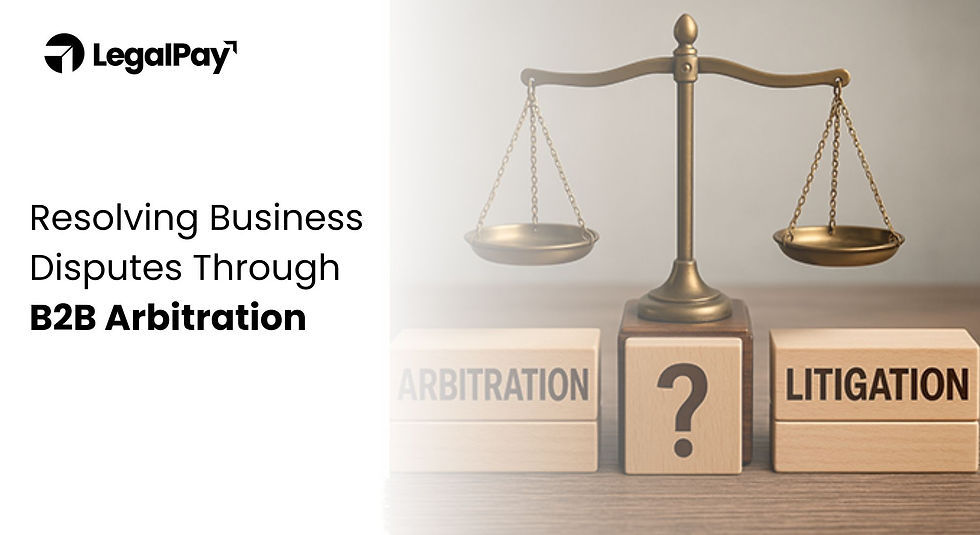Architects vs. Vendor Disputes- Payment Defaults and Prevention
- LegalPay

- Nov 14, 2023
- 6 min read
In the dynamic realm of architectural development, characterized by the expanding architectural infrastructure of nations, effective collaboration stands as an indispensable factor for project success. Within this context, where the foundational elements of architecture are rooted in materials like cement and bricks, the roles of both architects and vendors hold paramount significance. Despite their critical roles in ensuring the smooth progress of a project, disputes may arise, often stemming from a breakdown in trust. The trust serves as the bedrock of these partnerships, yet it can erode when vendors fail to deliver materials on time or when architects delay payments for essential supplies. When conflicts emerge between architects and vendors, it becomes vital to address these issues professionally and constructively to maintain the project's integrity. While precautions and measures can be taken to prevent disputes, occasional conflicts persist, prompting the exploration of litigation financing as a viable and ethical means for resolving these disputes through legal channels.

How to Resolve Disputes Between Architects and Vendors
The construction industry is often fraught with disputes between architects and vendors, who may have conflicting interests, expectations, or interpretations of the project. These disputes can result in delays, cost overruns, and compromised quality, affecting the project’s success and the parties’ reputation. Therefore, it is essential to have effective strategies for preventing and resolving disputes between architects and vendors.
Here are some tips on how to resolve disputes between architects and vendors:
Open Communication: Effective communication forms the cornerstone of dispute resolution. Architects and vendors must maintain open lines of communication from the project’s inception, which includes regular meetings, progress updates, and timely addressing of concerns. Misunderstandings often stem from a lack of communication, underscoring the importance of keeping all involved parties informed and involved.
Defined Contracts: Poorly defined contracts often serve as a primary cause of disputes between architects and vendors. Hence, both parties should ensure that contracts are comprehensive, outlining expectations, timelines, and deliverables in meticulous detail. Clear and specific contracts simplify the process of addressing issues or disputes by referring back to the agreed-upon terms.
Mediation and Dispute Resolution Clauses: Incorporating mediation and dispute resolution clauses in contracts can help prevent conflicts from escalating into protracted legal battles. Mediation allows a neutral third party to facilitate a resolution that satisfies both parties. These clauses offer a structured process for resolving conflicts without resorting to costly litigation, promoting a more amicable and efficient resolution process.
Regular Progress Assessments: Frequent progress assessments aid in the early identification of potential issues. Architects and vendors should collaborate on routine assessments to ensure that the project adheres to the outlined plan. This proactive approach can prevent minor disputes from snowballing into more significant problems that disrupt the project’s progression.
Comprehensive Documentation: Maintaining thorough records of all project-related communication, changes, and decisions is imperative. Comprehensive documentation can serve as vital evidence in the event of a dispute. A well-maintained paper trail facilitates the resolution of conflicts and minimizes the risk of disputes arising from conflicting claims or memories.
Problem-Solving Mindset: When disputes arise, adopting a problem-solving mindset rather than a confrontational one can be instrumental. Understanding that disagreements are a natural part of the construction process, parties should prioritize finding solutions that benefit the project rather than assigning blame. This shift in perspective fosters a more collaborative and constructive approach to dispute resolution.
Seeking Expert Advice: If direct communication and mediation fail to resolve a dispute, seeking advice from legal professionals or industry experts specializing in construction disputes may be necessary. Their expertise can provide valuable insights, clarify complex issues, and facilitate a resolution that aligns with legal regulations and industry best practices.
Consideration of Compromise: In many cases, a willingness to compromise can expedite resolution. Both architects and vendors should remain open to adjusting certain project aspects to reach a mutually acceptable agreement. While compromises may not yield perfect solutions, they enable practical outcomes that enable the project to progress without prolonged disputes.
Maintenance of Professional Relationships: Even during the height of a dispute, maintaining professionalism is crucial. Recognizing that the relationship between parties may extend beyond the current project, maintaining a reputation for professionalism and collaborative problem-solving can yield long-term benefits for both parties involved.
By following these tips, architects and vendors can resolve disputes in a timely and effective manner, ensuring the successful completion of the project and the satisfaction of all stakeholders.
Litigation Finance: A Game-Changer for Dispute Resolution in the Construction Industry
The construction industry is often riddled with disputes between architects and vendors, who may have divergent interests, expectations, or interpretations of the project. These disputes can result in costly and time-consuming litigation or arbitration, affecting the project’s success and the parties’ reputation. Therefore, it is vital to have effective strategies for preventing and resolving disputes between architects and vendors.
One such strategy is litigation finance, also known as third-party funding, which has emerged as a game-changer for dispute resolution in the construction industry. Litigation finance is a mechanism or process through which litigants or law firms can finance their litigation or other legal costs through a third-party funder, who invests in the case in exchange for a share of the proceeds from a successful claim. Litigation finance can offer several notable benefits for architects and vendors involved in disputes, such as:
Financial Support: Litigation finance provides the necessary capital to cover the legal expenses associated with dispute resolution, such as legal fees, expert witness fees, court fees, and other costs. This allows architects and vendors to pursue their claims or defences without undue financial strain or compromising their cash flow and operational budget.
Risk Mitigation: Litigation finance helps distribute the financial risk associated with dispute resolution. Third-party funders assume a portion of the financial risk when investing in a case, and typically do not require repayment if the case is unsuccessful. This alleviates the financial burden on architects and vendors and makes legal recourse more feasible and attractive.
Focus on Substantive Issues: With the support of litigation finance, architects and vendors can focus on the substantive issues of the dispute, rather than being distracted by concerns about costs and financial strain. This enables a more comprehensive and strategic approach to the case, fostering a more thorough and effective resolution process.
Empowerment in Settlement Negotiations: The knowledge that they have the financial backing of a litigation finance provider can empower architects and vendors during settlement negotiations. It underscores their commitment to resolving the dispute and their capacity to pursue it to a resolution, potentially encouraging the opposing party to seek a reasonable settlement or avoid litigation altogether.
Enhanced Access to Legal Expertise: Litigation finance providers often possess extensive experience and knowledge within the legal industry, enabling architects and vendors to connect with legal professionals specializing in construction disputes. This expanded access to legal expertise strengthens the parties’ chances of achieving a successful resolution and enhances the quality of their legal representation.
Potential for Non-Recourse Funding: In some cases, architects and vendors can secure non-recourse funding, where repayment to the litigation finance provider is contingent on the case’s success. This additional layer of financial protection provides a safety net that mitigates potential losses in the event of an unfavourable resolution.
Conflict Avoidance: Litigation finance can also function as a mechanism for avoiding disputes altogether. By providing funding for alternative dispute resolution methods, such as mediation or arbitration, architects and vendors can explore mutually agreeable solutions before resorting to more costly and adversarial litigation, fostering a more harmonious and collaborative project environment.
Timely Resolution: With the financial backing of a litigation finance provider, architects and vendors gain the resources to expedite the resolution process. This proves particularly beneficial in construction projects, where delays can result in substantial financial consequences and potential setbacks to the project’s overall timeline.
By employing litigation finance, architects and vendors can transform the way they resolve disputes in the construction industry, ensuring the successful completion of the project and the satisfaction of all stakeholders. Litigation finance is a modern and innovative tool that offers access to justice, financial support, risk mitigation, and strategic advantage for parties involved in disputes.
Conclusion:
In the intricate realm of architectural development, where the synergy between architects and vendors is crucial for the successful execution of projects, effective payment defaults and prevention dispute resolution stand as a cornerstone for sustained progress. Through the proactive implementation of strategies such as open communication, clearly defined contracts, and regular progress assessments, professionals can mitigate potential conflicts and foster a culture of transparency and accountability. Emphasizing the importance of maintaining a problem-solving mindset and the cultivation of professional relationships, stakeholders can ensure that disputes do not overshadow the collaborative spirit essential for project success.
Furthermore, the introduction of litigation financing has revolutionized the landscape of dispute resolution, providing architects and vendors with the necessary financial support to navigate complex legal challenges without straining their resources. By spreading the risk, enabling focused negotiations, and facilitating access to specialized legal expertise, litigation financing has emerged as a transformative tool for efficient conflict resolution. Its potential for non-recourse funding and conflict avoidance mechanisms offers a pathway for constructive resolutions that prioritize the long-term success of projects and professional relationships.
In essence, the dynamic intersection of proactive strategies and the innovative potential of litigation financing not only paves the way for efficient dispute resolution but also reinforces the ethos of trust and collaboration within the architectural community. By upholding these principles, architects and vendors can set a precedent for a resilient and thriving architectural landscape that thrives on open communication, mutual respect, and a shared commitment to excellence.




Comments